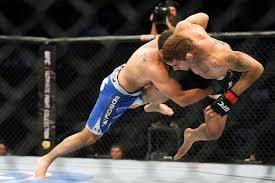 Dall’archivio del Bar Frankie, pubblicazione originale del Ottobre 2012.
Dall’archivio del Bar Frankie, pubblicazione originale del Ottobre 2012.
ITALIAN (ORIGINAL) VERSION
Sono arrivate anche in Italia le MMA. Non si tratta di una nuova droga o forse sì. MMA sta per “arti marziali miste” (mixed martial arts) ed è una disciplina che da poco si sta affermando nel circuito degli sport da combattimento. Ricordo ancora quando ne sentii parlare diversi anni fa da alcuni fighters statunitensi intervistati in un programma che andava in onda a tarda ora. Non vidi le immagini, ascoltai prima le loro dichiarazioni e pensai, da ingenuo quale ero (purtroppo sono cambiato poco), che noi cittadini europei eravamo i soliti bigotti, accettavamo sport violenti come il pugilato, il K1 o la thai boxe, ma non lasciavamo che questo nuovo sport da combattimento, con un approccio occidentale, potesse esprimersi liberamente. Qualche giorno dopo riuscii a vedere diversi incontri su internet, non rimasi traumatizzato, ma certamente disgustato. Gli atleti si scagliavano quasi immediatamente ai piedi dell’avversario per proiettarlo a terra e cercare di infierire su questi con leve, strangolamenti o serie di pugni al capo, dati come in preda ad un raptus, fortunatamente non erano molto precisi e, soprattutto, caricati data la distanza ravvicinata.
Forse è meglio procedere con ordine, anche se non è facile semplificare un mondo un po’ nebuloso, diviso in più federazioni e in divenire come quello delle MMA. Purtroppo per voi non riuscirò ad esaurire la discussione su questo sport in un unico articolo, (non è una minaccia, ma una promessa che spero di onorare in tempi ragionevoli se potrà interessare alla nostra sempre più numerosa comunità) in questo tenterò di partire dall’essenziale, darne una piccola definizione senza dilungarmi troppo e soprattutto verrà fuori la mia opinione, sicuramente opinabile e non da tecnico o praticante, ma sono abituato a stare “in minoranza”, anche perché il mio modo di intendere lo sport è un po’ donchisciottesco.
Come ho anticipato in precedenza, le regole d’ingaggio permettono di colpire l’avversario con tecniche libere di calcio, gomito, pugno e ginocchio quando si sta in piedi e, a differenza del K1 o della boxe, savate, ecc…inoltre si può calciare toccando il pavimento con le mani. Gli atleti meno preparati in questo tipo di combattimento, da striker, (sono definiti così i praticanti di boxe, kick boxing o thai boxe) preferiscono gettarsi ai piedi dell’altro per proiettarlo o comunque lottare corpo a corpo. Questo è l’atteggiamento che prevale negli incontri perché la maggior parte degli atleti ha esperienze in discipline come il judo, il grapling, il wrestling (Brock Lesnar), o meglio ancora la vale tudo e il Brazilian ju jitsu (BJJ), quasi d’obbligo per chi dovesse intraprendere questo tipo di percorso. La fase in piedi solitamente è breve, anche se non è la regola, dipende sempre dalla preparazione marziale del fighter. Il più veloce cerca di proiettare a terra l’avversario e, se riesce a stare in posizione dominante, “di monta” (tecnicamente quando uno dei due siede sull’altro e lo colpisce con tecniche di braccia) parte una delle tecniche più apprezzate dagli spettatori, il ground and pound (consiste nel colpire l’avversario sottomesso ripetutamente con pugni e gomitate; in genere è applicata dai lottatori che sanno difendersi dalle tecniche di sottomissione, come i wrestler e i judoka). Chi è nella posizione dominante se si trova di fronte ad un atleta non troppo preparato a fronteggiare questo tipo di situazione continua fino a quando l’arbitro, materialmente, non gli si scaglia addosso e lo strattona via, con il sottomesso svenuto, o quasi, a terra. Le ricerche della Johns Hopkins University dimostrano che i KO nelle competizioni di MMA sono numericamente inferiori rispetto alle competizioni di boxe e, addirittura, che nei matches di MMA c’è un minore rischio di lesioni traumatiche al cervello rispetto ad altri sport da combattimento che prevedono colpi alla testa, come la boxe. Sinceramente non ho avuto occasione di approfondire questo aspetto, sarò stato “sfortunato” io, ma di solito gli incontri che ho visto sono finiti prima del limite con un’alta percentuale di svenuti. L’ultimo proprio venerdì sera (20/10/2012), in seconda serata in uno dei canali del digitale terrestre che settimanalmente propone fighters che si affrontano in un noto locale londinese che fa da arena ai moderni gladiatori, che “allietano” i pasti dei clienti. Attualmente sul piano della sicurezza sono state apportate delle migliorie, anche se insufficienti per me: prima erano vietati solo i colpi ai genitali e le dita negli occhi. L’unica “protezione” indossata erano i guanti, ma talvolta non venivano obbligati a portare neppure quelli. Oggi, perlomeno, i medici controllano gli atleti prima delle gare e gli spalmano sul viso la vaselina per permettere ai colpi incassati di “scivolare” e tutelare un minimo la cute da abrasioni e tagli. Nell’intervallo tra un round e l’altro i medici controllano se i lottatori siano in condizione di continuare il combattimento, o costretti a fermarsi per via di ferite rilevanti (KO tecnico). Per quanto riguarda le protezioni, è obbligatorio l’uso del paradenti, bendaggi sotto guanto e sospensorio. Sono vietate le ginocchiate in volto all’avversario se questi è a terra o in ginocchio e non è permesso colpire alla schiena o dietro la testa, anche se nella foga capita che colpi sferrati alla testa vadano ad impattare la nuca, ma fino a qui niente di nuovo per chi è abituato a seguire sport da ring. Come tutte le competizioni marziali i contendenti devono rientrare in determinate categorie di peso, questo solitamente è il metro di abbinamento degli atleti, anche se una certa influenza la gioca il numero di gare disputate, specialmente all’inizio della carriera agonistica. Le regole universalmente accettate per quanto riguarda le protezioni e le tecniche di combattimento lecite risalgono all’aprile del 2000, le ha individuate la California State Athletic Commission.
…to be continued…
ENGLISH VERSION
They arrived in Italy the MMA. This is not a new drug or maybe yes. MMA stands for “Mixed Martial Arts” (mixed martial arts), and is a discipline that is emerging recently in the circuit of combat sports. I still remember when I heard about it several years ago by some U.S. fighters interviewed in a program that aired late at night. I saw the pictures, I listened to their statements and their first thought, as naive as I was (unfortunately changed little), that we Europeans were the usual bigots, we agreed violent sports such as boxing, K1, or Thai boxing, but we left that this new combat sports with a Western approach, could express themselves freely. A few days later I could see a number of meetings on the internet, I was not shocked, but certainly disgusted. Athletes who lashed out almost immediately at the foot of the opponent to throw him to the ground and try to rage on with these levers, chokes or series of punches to the head, as data in the throes of a fit, fortunately were not very accurate and, above all, loaded given the close range.
Perhaps it is best to proceed with order, although it is not easy to simplify a world a little ‘hazy, divided into several federations and become like that of MMA. Unfortunately you will not be able to exhaust the discussion on this sport in a single article (it is not a threat but a promise that I hope to meet within a reasonable time will be of interest to our growing community) in this attempt to go from ‘ essential to give a little definition without dwelling too much and especially will come out in my opinion, questionable and certainly not as a coach or practitioner, but I am used to being “in the minority”, because my understanding of the sport is a bit ‘quixotic .
As I mentioned earlier, the rules of engagement allow you to hit your opponent using techniques of soccer, elbow, hand and knee when standing and, unlike the K1 or boxing, savate, etc. … also you can kick touching the floor with your hands. Athletes less prepared in this kind of combat, striker, (defined as practitioners of boxing, kick boxing or Thai boxing) prefer to throw himself at the feet of the other to throw or otherwise grappling. This is the attitude that prevails in the meetings because most of the athletes has experience in disciplines such as judo, grapling, wrestling (Brock Lesnar), or better still worth tudo and Brazilian ju jitsu (BJJ), almost d ‘obligation for those who would undertake this type of journey. The step up is usually short, although it is not the rule, always depends on the preparation martial fighter. The fastest tries to project down their opponent and if he can be in a dominant position, “breeding” (technically when one sits on the techniques and hits him with arms) part one of the techniques most appreciated by spectators, the ground and pound (is to hit the opponent with fists and elbows subjected repeatedly, usually is applied by fighters who know how to defend themselves from the techniques of submission, as the wrestler and judoka). Who is in a dominant position if it is in front of an athlete is not too prepared to face this kind of situation continues until the referee, materially, not railed on him and pulls away, with the submissive unconscious, or nearly so, to the ground. Research at Johns Hopkins University show that KO in MMA competitions are outnumbered boxing competitions, and even in matches that MMA is a lower risk of traumatic brain injury than other combat sports involving blows to the head, like boxing. Honestly, I have not had the opportunity to explore this aspect, I was “unfortunate” me, but usually the meetings that I have seen are finished before the limit with a high percentage of passed out. The last its Friday evening (20/10/2012), in the late evening in one of the channels of digital terrestrial television that offers weekly fighters facing each other in a well-known local London which is the arena of modern gladiators, “cheer” meals customer. Currently in terms of safety improvements have been made, although insufficient for me before they were banned only the blows to the genitals and fingers in my eyes. The only “protection” were worn gloves, but sometimes were not even required to wear them. Today, at least, doctors monitor the athletes before competition and smear Vaseline on the face to allow climb-downs of “slip” and protecting the skin from a minimum abrasion and cuts. In the interval between one round and the other doctors check to see if the wrestlers are in a position to continue the fight, or forced to stop because of injuries relevant (TKO). With regard to protection, it is compulsory to wear a mouth guard, gloves and bandages under jockstrap. Are prohibited knee in the opponent’s face if he is on the ground or kneeling and not allowed to hit back or behind your head, even if it happens that in the heat blows to the head should be to impact the neck, but far nothing again to those who are accustomed to follow a ring sport. Like all martial competitions contenders must fall within certain categories of weight, this is usually the combination meter athletes, although some influences play the number of games played, especially early in the career. Universally accepted rules regarding the protection and fighting techniques dating back to April of 2000, lawful, has identified the California State Athletic Commission.
…to be continued…




